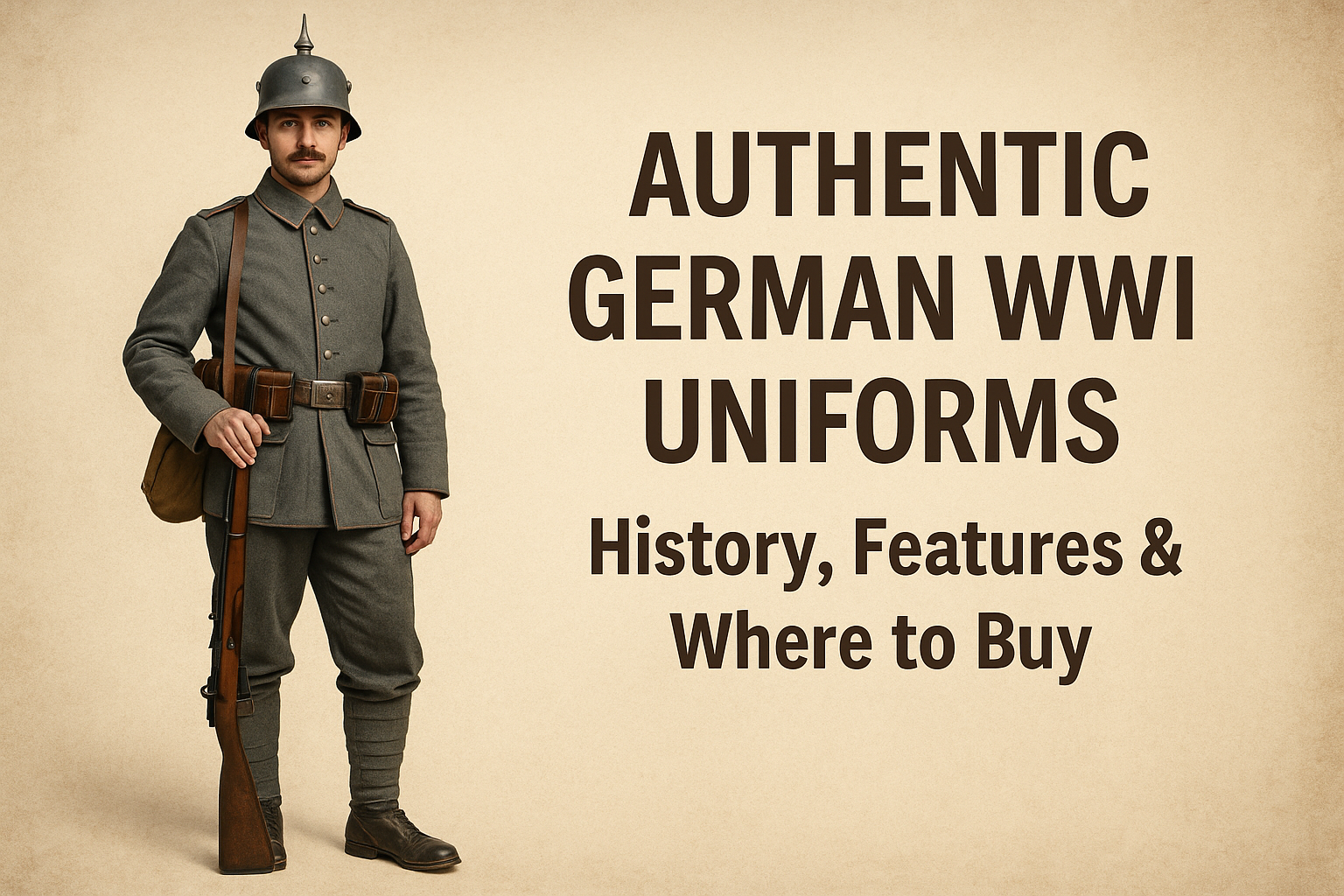
Authentic German WWI Uniforms – History, Features & Where to Buy
Published on Jun 30, 2025
A Timeless Symbol of History: German WWI Uniforms
When you picture a soldier from the early 20th century, chances are that the image of a German WWI uniform comes to mind. The grey wool, distinctive Pickelhaube helmets, and meticulously crafted details reflect the era’s military pride and industrial precision. As WWI unfolded, uniforms became more than just garments—they were emblems of strategy, hierarchy, and evolving warfare needs.
In this post, we explore the rich history and design of German WWI uniforms, compare them with other military apparel from different eras, and guide you on where to find authentic World War 1 German uniforms for sale.
The Origins of the German WWI Uniform
Before World War I in 1914, the German military wore vibrant, ornate uniforms influenced by Prussian military traditions. However, practicality soon overtook grandeur. With the intensity and scale of trench warfare, the need for more functional and less conspicuous attire became apparent.
Key Early Features:
- Color: Feldgrau (field gray), a subdued grey-green wool, replaced the earlier colorful tunics.
- Helmet: The iconic Pickelhaube (spiked helmet) was still in use in 1914 but was soon phased out due to its impracticality.
- Material: Wool was used for warmth, durability, and ease of production.
As the war progressed, the German uniform changed to increase mobility, comfort, and camouflage—key advantages in trench and mechanized warfare.
Uniform Components Breakdown
Understanding the parts of a German WWI uniform helps collectors and reenactors appreciate their functionality:
- Tunic (Blue):
- Feldgrau wool with red piping (phased out in later years)
- Often adorned with shoulder boards indicating rank
- Trousers (Hosen):
- Simple, straight-leg wool trousers in matching grey
- Some included knee reinforcements for durability
- Helmet (Pickelhaube / Stahlhelm):
- Initially, leather spiked helmets were replaced by the Stahlhelm in 1916 for better protection
- Puttees:
- Cloth strips wrapped around the lower legs for support and warmth
- Boots (Marschstiefel):
- High leather jackboots, iconic of the German soldier’s image
German WWI vs. East German Uniforms
Though from vastly different periods, East German uniforms (from the German Democratic Republic era) still reflect some influence from earlier designs. The East German uniform (also known as the NVA uniform) was more standardized and practical, often associated with Cold War surveillance and Soviet-style military discipline.
Key Differences:
- Material: East German uniforms used synthetic fabrics for mass production.
- Color: Slightly darker grey-blue, with Soviet-inspired tailoring.
- Emblems: Included NVA insignia, epaulettes, and state symbolism.
While WWI uniforms were shaped by imperial tradition and battlefield necessity, East German uniforms echoed political alignment and Cold War efficiency.
British WW2 Soldier Uniforms: A Comparative Look
Comparing WW2 British soldier uniforms with their German WWI counterparts reveals striking contrasts in military philosophy and battlefield adaptation:
FeatureGerman WWI UniformWW2 British Soldier Uniform
Color Feldgrau (grey-green) Khaki (brownish-green)
Helmet Stahlhelm Brodie helmet
Material Wool Wool, cotton blends
Design Focus Durability and regimental pride Mobility, camouflage, and utility
Pockets Minimal Multiple for gear storage
British WW2 uniforms were functionally superior in camouflage and logistics but lacked the ornate details of early German uniforms.
Prussian Influence: Napoleonic Roots
Many elements of the German WWI uniform trace back to the Prussian uniforms from the Napoleonic Wars. The emphasis on order, discipline, and sharp design began with the Prussian army’s blue tunics, high boots, and tall shakos.
The transformation over the centuries—from Prussian elegance to WWI pragmatism to East German minimalism—tells a broader story of Europe’s shifting military needs and ideologies.
World War 1 German Uniforms for Sale – What to Look For
Collectors and reenactors searching for World War 1 German uniforms for sale should focus on authenticity, material quality, and historical accuracy. Whether you're buying original pieces or high-quality reproductions, here are key tips:
- Check Fabric Type: Genuine wool or high-grade replicas
- Verify Badges and Insignia: Ensure correct regimental markings
- Ask for Provenance: For original items, historical documentation adds value
- Use Reputable Sellers: Platforms like Paddelaters specialize in curated military apparel
Reenactment, Collection & Display: Why These Uniforms Still Matter
From historical reenactments to museum exhibitions, WWI German uniforms serve as living history. They represent the men who lived through one of the most devastating global conflicts and serve as a bridge between the past and the present.
Collectors often display uniforms in dedicated spaces, while reenactors bring them to life in events across Europe and the United States. Students and historians use these garments as primary sources of study.
Where to Find Authentic WWI German Uniforms Online
If you're searching for German WWI uniforms for sale, Paddelaters.com offers a curated collection of military uniforms from different eras, including:
- Authentic WWI German tunics, trousers, and helmets
- East German uniforms from the Cold War era
- WW2 British soldier uniforms for reenactment and collection
- Prussian uniforms from Napoleonic wars – a true collector's gem
With secure shopping, detailed product descriptions, and passionate expertise, Paddelaters is a trusted resource for military history enthusiasts.
Conclusion: Preserving the Legacy, One Uniform at a Time
German WWI uniforms are more than fabric and buttons—they’re a gateway to understanding a pivotal era in human history. Comparing them to East German and British WW2 military attire gives us deeper insight into the evolving nature of war, society, and symbolism.
Whether collecting, reenacting, or researching, the availability of World War 1 German uniforms for sale ensures that this important legacy lives on.
